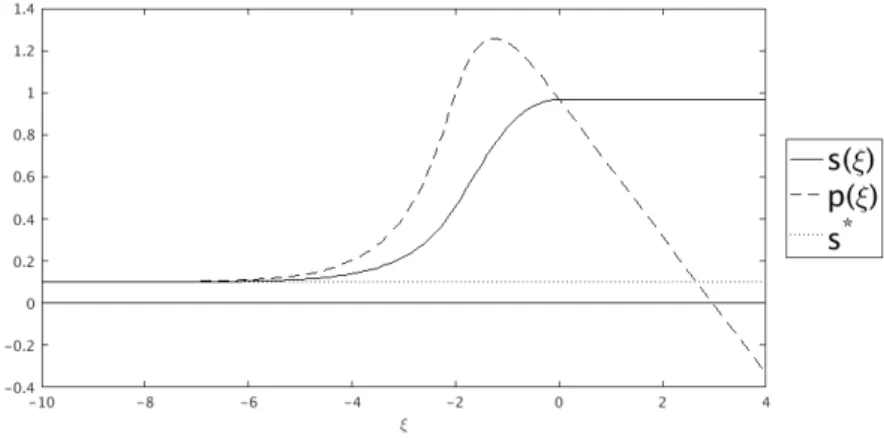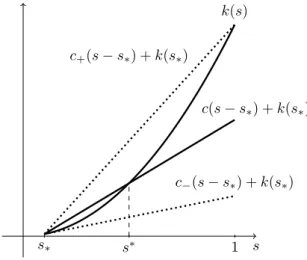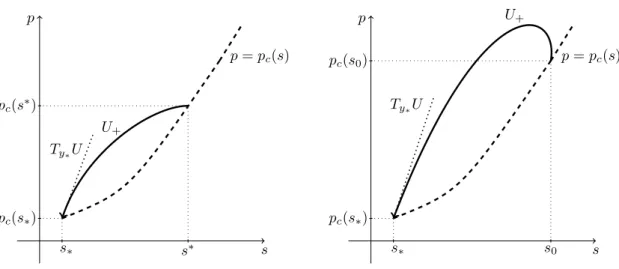Traveling wave solutions for the Richards equation with hysteresis
E. El Behi-Gornostaeva, K. Mitra, B. Schweizer
Preprint 2018-05 September 2018
Fakultät für Mathematik
Technische Universität Dortmund Vogelpothsweg 87
44227 Dortmund tu-dortmund.de/MathPreprints
equation with hysteresis
E. El Behi-Gornostaeva 1 , K. Mitra 2 , B. Schweizer 1
September 24, 2018
Abstract: We investigate the one-dimensional non-equilibrium Richards equation with play-type hysteresis. It is known that regu- larized versions of this equation permit traveling wave solutions that show oscillations and, in particular, the physically relevant effect of a saturation overshoot. We investigate here the non-regularized hysteresis operator and combine it with a positive τ -term. Our result is that the model has monotone traveling wave solutions.
These traveling waves describe the behavior of fronts in a bounded domain. In a two-dimensional interpretation, the result character- izes the speed of fingers in non-homogeneous solutions.
MSC: 76S05, 74N30, 35C07
Keywords: porous media, hysteresis, traveling wave, saturation overshoot
1 Introduction
When water is infiltrating a porous medium, the process can show a homogeneous saturation front or the formation of fingers; in the latter case, water enters preferen- tially along thin channels of high water saturation. We study a mathematical model for unsaturated flow in porous media. We investigate a non-equilibrium Richards equation with hysteresis, a model that allows the formation of fingers.
We are interested in the propagation of saturation profiles and restrict ourselves to the one-dimensional case. The main result of this contribution is that there exist, for appropriate parameter ranges, monotone traveling wave solutions for the system.
In the case of a homogeneous front, the traveling wave describes the propagation of the front. In the case of fingering, the traveling wave describes the saturation profile in one finger. Our results predict the speed of the finger, but they also yield that, possibly after a transition time, no overshoot occurs in the finger tip, even in the case of a positive redistribution time τ.
1
Fakult¨ at f¨ ur Mathematik, TU Dortmund, Vogelspothsweg 87, 44227 Dortmund, Germany
2
Department of Mathematics and Computer Science, TU Eindhoven, PO Box 513 5600 MB
Eindhoven, The Netherlands
Before we compare our results with the existing literature, we formulate the model problem. Spatial points of the one-dimensional system are denoted by x ∈ R , time instances are denoted by t ∈ [0, ∞). The physical state in (x, t) is described by two variables: saturation ˜ s and pressure ˜ p. The tilde marks functions that depend on space and time, ˜ s, p ˜ : R × [0, ∞) → R in the case of entire domains. Combining Darcy’s law with mass conservation yields the unsaturated media flow equation
∂
t˜ s = ∂
x[k(˜ s)(∂
xp ˜ + 1)] . (1.1) In this equation, we have normalized the porosity of the medium. Gravity points in negative x-direction and is also normalized. The hydraulic conductivity k is a given coefficient function s 7→ k(s); it is a nonnegative and nondecreasing function.
Equation (1.1) is complemented with a constitutional law that relates pressure and saturation. Models for slow processes without hysteresis use an algebraic rela- tion: With a given capillary pressure function p
cone demands ˜ p = p
c(˜ s). We can include non-equilibrium effects (τ > 0) and play-type hysteresis (γ > 0) in the form
˜
p ∈ p
c(˜ s) + γ(˜ s) H(∂
t˜ s) + τ ∂
t˜ s . (1.2) In this relation, [0, 1] 3 s 7→ p
c(s) ∈ R is a given non-decreasing function, the capillary pressure curve for imbibition. The real parameter τ ≥ 0 is a measure for a redistribution time in the microscopic geometry. The function γ : [0, 1] → [0, ∞) is a measure for the hysteretic width; one often uses a constant function and writes γ ∈ [0, ∞). The multivalued function H is the step function
H(ζ) :=
0 for ζ > 0 , [−1, 0] for ζ = 0 ,
−1 for ζ < 0 .
In the equilibrium case τ = 0, the model imposes that imbibition (∂
t˜ s > 0) occurs always with the imbibition capillary pressure ˜ p = p
c(˜ s), while drainage (∂
ts < ˜ 0) occurs always with the drainage capillary pressure ˜ p = p
c(˜ s) − γ(˜ s).
The above model (1.1)–(1.2) has received considerable attention in recent years.
It was suggested and studied in [1, 7] as a natural extension of the Richards equation.
It is thermodynamically consistent and includes the hysteresis effect with a play- type model. We note that Richards emphasizes in his famous article of 1931 the importance of hysteresis. For an overview regarding hysteresis modelling and the development of the mathematical theory see [17].
Further research on (1.1)–(1.2) was mainly performed along three different lines:
A. Analysis of the hysteresis system in arbitrary dimension and fingering effect.
It was shown that the above system is well-posed for constant γ and positive per- meability k [11], that solutions are unique [2], that the system does not define an L
1-contraction (and hence allows for the fingering effect) [16], and that it indeed can produce the fingering effect, see e.g. [14]. Two-phase flow equations are treated in [3] and [10]. For a stability analysis for the system without hysteresis see e.g. [6].
B. Numerical methods. The numerical investigations of [8] and [18] are per-
formed in order to detect the occurance of saturation overshoots (see below in part
s p
0 1
p
c(s)
p
c(s) − γ(s)
Figure 1: Sketch of the constitutive relation between saturation s and pressure p using play-type hysteresis (τ = 0).
C) and their dependence on the data of the problem. Saturation plateaus are re- covered in [18]. In [15], a numerical scheme is suggested for a version of the above equations with non-vertical scanning curves. Indeed, introducing third order splines as scanning curves seems to facilitate the Newton iterations in a numerical scheme.
A numerical analysis of a discontinuous Galerkin scheme is performed in [9].
C. One-dimensional analysis and saturation overshoots. Much of the analysis in this field (including this contribution) is motivated by the effect of saturation overshoots: Experiments show that an imbibition front can be non-monotone. In this case, the saturation directly behind the front is higher than at larger distance (behind the front) [5]. Even though the experimental results come with large errors, one may interpret that the saturation forms plateaus. This is consistent with the shape of solutions to Riemann problems and is well understood in the case of two- phase flow equations [22]. It is also well understood that a positive parameter τ in (1.2) can produce non-monotone profiles, see [4, 19] for systems without static hysteresis, and [21, 12] for the full system. The methods are based on phase-space analysis of ordinary differential equations. For an early result in a problem with adsorption, see [20].
Traveling waves
In order to discuss traveling waves in further detail, we specify initial and boundary conditions for the above systems. Let 0 < s
∗∈ R denote the initial saturation and 0 < F
0∈ R prescribe an inflow at the top boundary (x = +∞). We then complement (1.1)–(1.2) by
˜
s(x, 0) = s
∗for every x ∈ R , (1.3a)
˜
s(x, t) → s
∗as x → −∞ for every t ∈ (0, ∞) , (1.3b)
k(˜ s(x, t))[∂
xp(x, t) + 1] ˜ → F
0as x → +∞ for every t ∈ (0, ∞) . (1.3c)
Much of the one-dimensional analysis is concerned with traveling wave solutions.
In the traveling wave ansatz, one seeks profile functions s, p : R → R and a scalar velocity c > 0 such that the time-dependent functions have the special form
˜
s(x, t) := s(x + ct) , p(x, t) := ˜ p(x + ct) . (1.4) Equations (1.1)–(1.2) provide the following system for s, p : R → R and c > 0:
c∂
xs = ∂
x[k(s)(∂
xp + 1)] , (1.5) p ∈ p
c(s) + γH(∂
xs) + τ c∂
xs , (1.6) where we used H(c∂
xs) = H(∂
xs) for positive c ∈ R . The boundary conditions are
s(ξ) → s
∗as ξ → −∞ , (1.7a)
k(s(ξ))[∂
xp(ξ) + 1] → F
0as ξ → +∞ . (1.7b) Main result. Our main result regards traveling waves in the case that drainage does not occur. This happens in the physical experiment when γ is large compared to the front width. Mathematically, we set γ = +∞ in the system or, formally more correct: We replace (1.6) by the two conditions:
p(ξ) = p
c(s(ξ)) + τ c∂
xs(ξ) if ∂
xs(ξ) > 0 , (1.8a) p(ξ) ≤ p
c(s(ξ)) + τ c∂
xs(ξ) if ∂
xs(ξ) = 0 , (1.8b) and we demand ∂
xs(ξ) ≥ 0 for all ξ ∈ R . We emphasize that the case γ = +∞ is of physical relevance in the effect of gravity fingering, see the discussion in Section 4.
Essentially, our main result states that for every s
∗∈ (0, 1) and every small flux F
0> 0, there exists a monotone traveling wave solution s, p : R → R and c > 0.
Theorem 1.1. Let k and p
cbe coefficient functions as specified in Assumption 2.2 below. Let s
∗∈ (0, 1) and F
0> 0 be boundary data of the problem. With c
−= k
0(s
∗) as in (3.6) we demand that the flux satisfies the bounds k(s
∗)+c
−(1−s
∗) < F
0< k(1).
We use c ¯ = ¯ c(k, s
∗, F
0) from relation (3.17) below.
There exists a critical value τ
∗= τ
∗(k, p
c, s
∗, F
0) ≥ 0 such that, for every τ > τ
∗, there exists a velocity c ∈ (c
−, ¯ c) and a traveling wave solution (s, p) to the system (1.5), (1.7), and (1.8).
2 Reformulation of the traveling wave equations
We will construct solutions to (1.5), (1.7), and (1.8) in a special form: We obtain
saturation profiles s that are constant for ξ > 0 and pressure profiles p that are affine
for ξ > 0. The following lemma provides a simplified set of equations. Solutions to
the simplified equations can be extended as indicated above to find solutions to the
original problem.
Lemma 2.1 (Traveling wave equations on a half space). Let F
0, s
∗> 0 be boundary data and let s
0> 0 satisfy k(s
0) ≥ F
0. For c > 0 let (s, p) : (−∞, 0] → R × R be a classical solution of the ordinary differential equation
c(s − s
∗) = k(s) [∂
xp + 1] − k(s
∗) (2.1a)
p = p
c(s) + τ c∂
xs (2.1b)
on (−∞, 0), satisfying the conditions
s(ξ) → s
∗as ξ → −∞ , (2.2a)
s(0) = s
0, (2.2b)
∂
xs(0) = 0 , (2.2c)
c(s
0− s
∗) + k(s
∗) = F
0. (2.2d)
We furthermore assume that the function ξ 7→ s(ξ) is monotonically increasing on (−∞, 0).
If we extend s and p for ξ > 0 by setting
s(ξ) = s
0, (2.3a)
p(ξ) = F
0k(s
0) − 1
ξ + p
c(s
0) , (2.3b)
then the extended functions (s, p) : R → R × R solve the system (1.5), (1.7)–(1.8).
A numerically computed solution as in Lemma 2.1 is depicted in Figure 2.
Figure 2: A numerically computed traveling wave solution. The figure shows the saturation profile as a solid line and the pressure profile as a dashed line. The solution is computed for p
c(s) = s, k(s) = s
2, τ = 5, s
∗= 0.1, F
0= 0.25. We obtain numerically c = 0.2139 and s
0= 0.8013.
Proof. (a) Equations on (−∞, 0). Differentiating (2.1a) yields
c∂
xs = ∂
x[k(s)(∂
xp + 1)]
on (−∞, 0), which is (1.5). We demanded that s is monotonically increasing on (−∞, 0), hence ∂
xs > 0 holds and we are always in the first case of (1.8) on that interval. Therefore (2.1b) implies (1.8) on (−∞, 0).
(b) Boundary conditions. Condition (2.2a) is equivalent to (1.7a). In order to verify (1.7b), we differentiate (2.3b). We obtain for any ξ > 0
k(s(ξ))(∂
xp(ξ) + 1) = F
0,
since s(ξ) ≡ s
0by (2.3a). This yields (1.7b).
(c) Equations on (0, ∞). The extensions of s and p in (2.3) are defined in such a way that ∂
xs ≡ 0 and ∂
xp + 1 ≡ F
0/k(s
0) holds on (0, ∞). Since k(s) is constant, we see that both sides of equation (1.5) vanish.
We check that (1.8) holds on (0, ∞): There holds ∂
xs ≡ 0, hence we are in the second case of (1.8). The pressure satisfies p ≤ p
c(s
0) by definition in (2.3b) and the assumption F
0/k(s
0) ≤ 1. By s ≡ s
0we have verified (1.8).
(d) Equations in 0. We evaluate equation (2.1a) in ξ = 0 and insert (2.2b) to obtain
c(s
0− s
∗) = k(s
0)(∂
xp(0) + 1) − k(s
∗) . Condition (2.2d) provides the value of the flux in 0,
k(s
0)(∂
xp(0) + 1) = F
0. (2.4)
Both, the saturation s and the flux quantity [k(s)(∂
xp + 1)] are continuous in ξ = 0.
This implies that (1.5) holds in all of R .
In the following section we obtain our main result. We will show that, given F
0, s
∗> 0, we find c > 0, s
0> 0 with k(s
0) ≥ F
0, and s solving (2.1)–(2.2). We derive this result under the following assumptions on the functions k and p
c. Assumption 2.2. Let the coefficient function k : [0, 1] → [0, ∞) be of class C
1, non-decreasing and strictly convex, positive on (0, 1]. Let the coefficient function p
c: (0, 1) → R be of class C
1with p
0c(s) > 0 for all s ∈ (0, 1). We furthermore assume p
c(s) → ∞ for s % 1.
We remark that also other p
c-functions can be treated with our methods. We find the same results when the last part of Assumption 2.2 is replaced by: p
c(s) → ζ ∈ R for s % 1 and p
cis multi-valued with p
c(1) = [ζ, ∞).
3 Existence of hysteretic traveling wave solutions
In view of Lemma 2.1, our aim in the following is to construct solutions to system (2.1)–(2.2). The equations (2.1) can be written as
∂
xs p
!
= (p − p
c(s))/(cτ ) (c(s − s
∗) + k(s
∗))/k(s) − 1
!
. (3.1)
With the function
G(s) := G(s; c, s
∗) := c(s − s
∗) + k(s
∗)
k(s) − 1 , (3.2)
we can write the unknowns and the right hand side as y :=
s p
: (−∞, 0] → R
2, G(y) :=
(p − p
c(s))/(cτ ) G(s)
, (3.3)
and the dynamical system (3.1) in the plane reads
∂
xy = G(y) . (3.4)
We recall that the right hand side depends on k, c, s
∗, and τ . An example for the function G is sketched in Figure 3. The function always vanishes in s
∗. Our assumptions will make sure that G has a positive slope G
0(s
∗) and is negative in s = 1.
s G(s)
s
∗= 0.1
s
∗= 0.3
1
1 3





![Figure 6: A solution of the two-dimensional system corresponding to (1.1)–(1.2) with play-type hysteresis and τ > 0, for the setting see [14]](https://thumb-eu.123doks.com/thumbv2/1library_info/3644922.1502992/15.892.317.575.527.789/figure-solution-dimensional-corresponding-play-type-hysteresis-setting.webp)